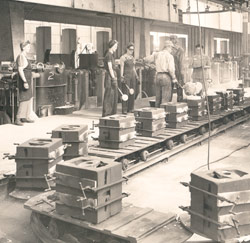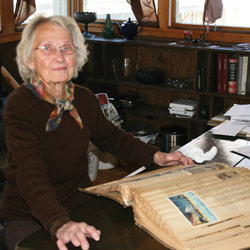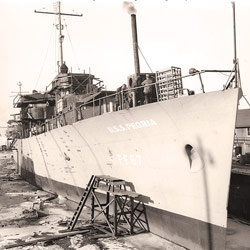While many American women held jobs prior to World War II, the needs and opportunities of that time in history led to a surge of women entering the workforce for the first time. Some responded to Uncle Sam’s call to aid their country, while others took advantage of the chance to make more money than they had in the past. Six million American women took jobs for the first time during the war, increasing the number of working women by a whopping 57 percent, and Peoria’s industrial center was a prime spot for local women to join the force.
For decades, women had been told that they belonged in the home. Those with outside jobs were expected to work traditional “women’s jobs” like teaching and nursing, and steer clear of the “masculine” positions that tended to pay more and offer more room for advancement. But when World War II came around and the men went off to war, societal change was inevitable. Women were suddenly needed in the workforce to fulfill the important jobs vacated by men—not only to produce consumer goods, but more importantly, to advance the war effort by producing munitions and building planes and ships. Yet this was to be a temporary situation, and after the war, these women were expected to return to their domestic roles.
Women Prove Willing
In order to take on industrial and defense jobs during the war, women had to make certain sacrifices. They were willing to get the training they needed—either at vocational schools or on the job—and many had to move to wherever the jobs were, which often meant leaving families behind.
The National Youth Administration ran a training program in Peoria to prepare young men and women to work in plants and produce war materials, reported a September 1942 Peoria Journal Transcript article. At that time, 76 of the 250 trainees in the program were women. The Peoria County vocational school for machine operators and welders also trained women for machine jobs in defense plants, according to a 1945 article.
To persuade women that they could handle such jobs, munitions making was likened to running a sewing machine or vacuum cleaner—activities with which women were familiar and proficient, according to Dr. Stacey Robertson, director of the women’s studies program at Bradley University. An American War Manpower Campaign in 1943, for example, featured a billboard that read, “If you’ve used an electric mixer in your kitchen, you can learn to run a drill press.” Even Caterpillar posted advertisements in local papers encouraging women to join the company. Some read: “Women Help Yourself and Uncle Sam by Getting a Good Job at Caterpillar,” “Help the Boys Overseas by Working at Caterpillar,” and “Women You Can Learn to Weld at Caterpillar.”
Women gladly answered the call, and after being trained, were quite proficient in their new positions. “Mr. Roark [secretary of the Peoria Manufacturers Association] insisted that women can do anything now that men can do in industrial occupations,” read a 1943 Peoria Star article. “In some instances, women are actually doing a better job than the men they replace.”
But hiring women meant that some changes had to be put in place. Some states had protective laws that kept women from doing night work, working overtime or doing heavy lifting—these had to be revised. Many factories had to make new accommodations, such as installing female restrooms, which had previously been unnecessary.  Motivation to Work
Motivation to Work
It’s interesting to note that while Uncle Sam was calling, it wasn’t patriotic duty that spurred most women to join the workforce—it was economic opportunity. Jobs previously held by men paid much more than those typically held by women, and women who were struggling to make ends meet were quick to jump at the chance to earn more money.
Manufacturing jobs allowed women to move up the ranks, accepting more responsibility as they went, but defense jobs were even better, as they paid 40 percent more than jobs that produced consumer goods. These jobs were primarily filled by white women. “African American women were pretty much squeezed out of these jobs,” noted Robertson. They took on the jobs that white women had left, receiving slightly more pay than at their original positions, which had consisted primarily of service and agricultural jobs.
Overall, women were paid less than their male counterparts who left for war; the rationale, said Robertson, was lack of experience. “By and large, pay depends on not only the type of job you’re working, but on experience, so certainly women with less experience, say, as welders or riveters, would be paid less.” Although efforts were made to ensure that female workers received equitable pay, usually by the unions, they weren’t well enforced or effective. And within the unions themselves, which women began to join during the war, they weren’t always welcomed by their fellow men.
Despite filling a critical niche during the war, women were often met with hostility by the men they worked for and alongside. “Men were concerned that following the war, the women would find these jobs satisfying in the way that they found them satisfying,” explained Robertson, and they often did. While many women would have liked to keep their wartime jobs, when the men returned home, most were forced to give them up.
The social construct that had been used to convince women of their ability to perform “men’s work” was quickly reversed after the war. Suddenly, women were told that they actually weren’t skilled enough to perform those jobs and that they were needed back in the home, where their “proper place” was. And while the majority of women lost the jobs they had taken during the war, the idea that they left the workforce entirely is incorrect. Indeed, many women did willingly return to their homes, but many also reclaimed the traditional “women’s jobs” they held before the war and continued working.
“To me, this is an opportunity to emphasize the idea that gender is a social construction and that the way we think about manhood and womanhood changes depending on what’s happening in the larger society,” noted Robertson. In this sense, World War II certainly presented a major shift in American society, and we see that as men went off to war, women were more than willing to adapt to the changing times and fill in for them here on the home front. iBi
 » Peoria’s Rosies
» Peoria’s Rosies
Women who took on such “masculine” jobs as riveting and welding during World War II were given the name “Rosie the Riveter.” In 2011, it’s getting more difficult to find real-life Rosies who are still able to share their stories of working industrial and defense jobs, but we were able to find a few. Read on to learn more about some of Peoria’s Rosies.
Gun Factory Worker
Vivian Moehle-Todden, a Rockford native, entered the workforce in 1944 while still a senior in high school. Like many of her peers, she wasn’t so much motivated by the patriotic call to help the war effort, but “had energy to burn…and after school, I needed something to do. The logical thing was to get a job,” she explained. Todden began working at Pierce Paper Products in Rockford, where she punched donuts out of large sheets of cardboard which would become the packing material for ammunition shells.
Upon graduating from high school, Todden wanted to leave home and have adventures, so she and a girlfriend set out for Cleveland, where they ran out of money and took jobs in a gun factory. “My friend ran a milling machine, and I ran a lathe, and it was simple,” she recalled. Neither job that she held during the war was difficult to learn or perform, and she worked primarily with other women, with whom there was great camaraderie. Having just graduated from high school, Todden and her friend were among the youngest of the bunch.
After making enough money in Cleveland to continue their travels, the two women left their jobs and headed further east, before returning to the Midwest to attend college. Todden attended Northwestern University, where she earned a degree in education. She eventually accepted a job teaching physical education at Woodruff High School, where she stayed for 45 years before retiring in 1993.
 Shipyard Welder
Shipyard Welder
Alice Harder Ragan loves to weld. It’s a love affair that began when she took a class at Bradley University during World War II. After completing her welding course, she met a scout from Sturgeon Bay, Wisconsin, who hired her on the spot to work at Leathem D. Smith Shipbuilding Co. With the war a drain on its workforce, the company was “experimenting” by hiring female welders to build its ships, and Ragan was among the first three female hires. A year later, after proving their success, the company employed 334 women.
In the two years and two months she spent in Sturgeon Bay, Ragan worked on several ships, mainly frigates and sub chasers, but her most memorable job was on the U.S.S. Peoria, named after her hometown. She recalls that she had to wear a leather jacket, pants and heavy-duty shoes while welding, as the flying sparks would burn holes right through her coveralls. When her shoes got especially worn, she would send them to her fiancé, a shoe repairman who she had initially met at Peoria’s Block & Kuhl department store, and he would send them back to her good as new.
Although she worked with other women at the shipyard, Ragan said they were simply too focused on getting the job done for there to be much camaraderie among them. There were, however, “bent noses” on some of the men with whom she worked. They resented two things about her—that she was a woman, and that she was from out of state. But her employer had no problem with her or the other women. Not only were they excellent workers, the women offered a competitive advantage—they were often able to fit into small places and perform welds the men were just too big to get to.
Caterpillar Employee
Helen Davis worked at Caterpillar for two years during the war, holding a variety of different positions in her time there. When the men returned home, she would be moved to a new position to make room for them, and eventually, she moved on to a job at the Hiram Walker bottling plant.
At that time, about 30 percent of Caterpillar’s workforce was comprised of women, and in the aluminum foundry at the East Peoria plant, women represented 85 percent. During the war, women served as factory clerks, did tracing and detail work in the engineering department, were chemists and testers in the metallurgical laboratory, operated nearly all types of machines and much more. Not only did they take on more roles, they also worked more hours, as plants, which were 100-percent war production plants, operated 24 hours a day, seven days a week.
Caterpillar’s equipment was found wherever Allied troops were during the war. Its track-type tractors, motor graders and other heavy equipment helped repair and build roads and construct airfields and bunkers. D7 tractors were used to bulldoze tank traps and build new ones to halt enemy counterattacks. Additionally, Caterpillar produced tank engines, transmissions and final drives; shells and bomb fuses; howitzer carriages; and armored versions of its track-type tractors, which they painted “olive drab” instead of the usual “highway yellow.”


